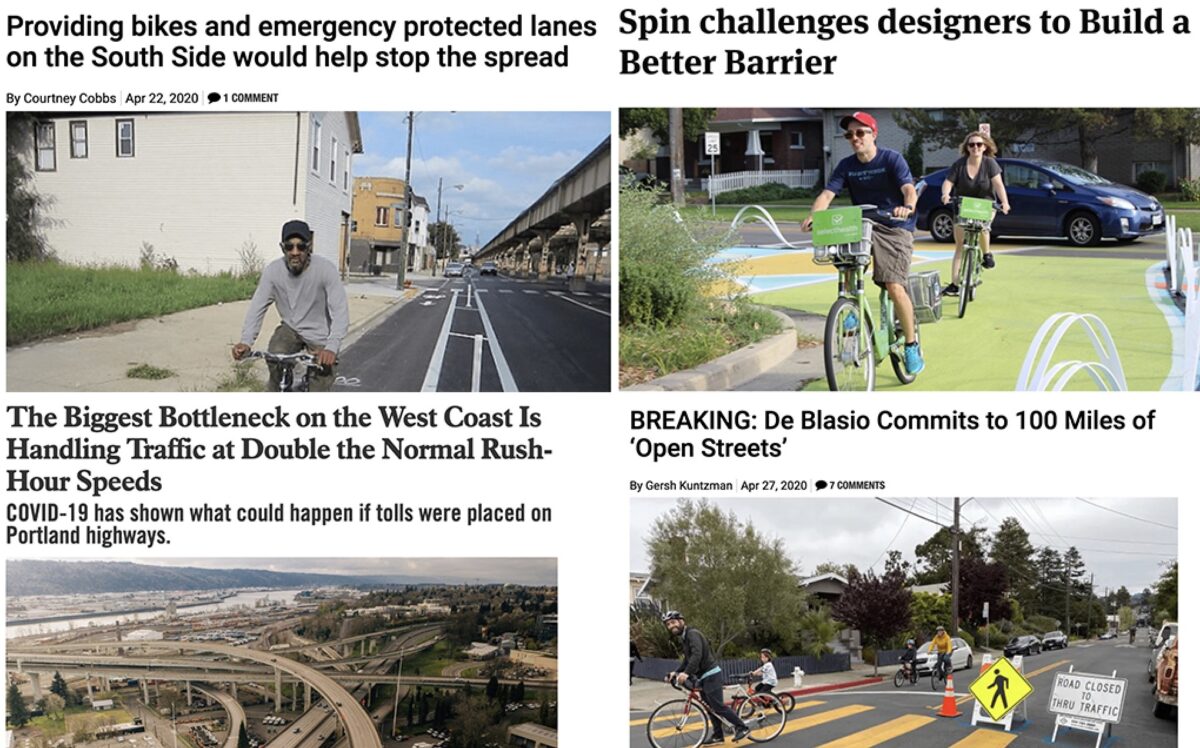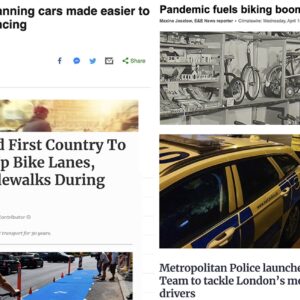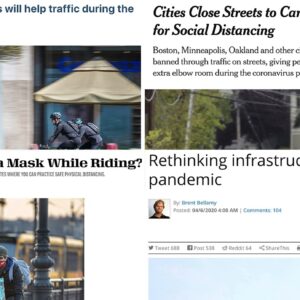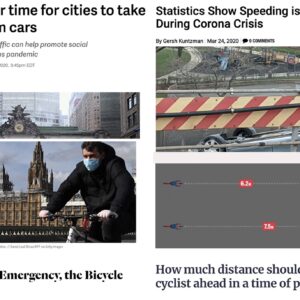This week’s Monday Roundup is sponsored by Western Bikeworks, the local source for all your riding needs!
Welcome to the week. Here are the most notable items our community came across in the past seven days…
As Portland leaders continue to sit on their hands and do nothing to adapt our streets to new mobility realities, a host of cities moved aggressively forward in the past week. Here’s a roundup:
Washington D.C.: Many people in Portland seem to think a massive open streets plan is the only thing we can do. That’s not the case at all. In D.C., they’ve decided to create temporary extended sidewalks adjacent to grocery stores so people have more room to queue.
Seattle: Our neighbors to the north are expanding their Stay Healthy Streets program with six more miles of roads where driving access will be limited in favor of walkers and bikers.
New York City: Once paired with Portland as a “progressive” big city that was responding feebly to the moment, NYC Bill de Blasio has finally seen the light and has committed to 100 miles of open streets.
Salt Lake City: Their “Stay Safe, Stay Active Streets” program has launched with a 1.3 mile stretch of road that will be open for bikers and walkers and can only be driven on by local traffic.
Milan: This Italian city never wants to go back to its polluted and car-dominated past and plans to “transform” 22 miles of streets in the coming months, “with a rapid, experimental citywide expansion of cycling and walking space to protect residents as Covid-19 restrictions are lifted.”
Paris: The capitol of France also wants to make sure bicycle riders are safe and their streets are healthy post-lockdown, so they’ve decided to create a whopping 650 kilometers of “pop-up cycleways”.
Advertisement
The political economy of car dependence: Seems like as good a time as any to bone up on new research about how the system creates car dependence and how we can break it.
Congestion relief: Turns out we can have a much more efficient and higher capacity freeway system at peak hours when we reduce demand — without spending $800 million on widening.
Father of ‘vehicular cycling’ dies: John Forester, author of Effective Cycling and the man who popularized “take the lane”, died at the age of 90. His impact on American cycling planning and culture was immense. Read an excellent and relatively recent interview with him here.
Know your history: Local architecture critic and writer Brian Libby shared a look back at the fight to turn Harbor Drive into Waterfront Park, 50 years after it happened.
Bikes FTW (again): Cycling proves its resilience yet again and experts in The Netherlands are among the many who think now is the moment to seize the streets and give cycling the space it deserves.
Barrier design: Micromobility company Spin has teamed up with Better Block for a design contest they hope will result in a better barrier to protect vulnerable road users from car drivers.
Clean air is possible: The research about air quality and links to Covid-19 deaths are striking.
Advertisement
The ‘plague’ of car culture: “Frankly, the idea that we can transport ourselves sustainably en masse in toxic 4,000-pound battering rams is just as delusional, entitled and self-destructive as the ‘liberate’ protestors who are demanding a premature end to coronavirus-related stay-at-home orders,” says this LA Times op-ed.
Commuting down: A Portland State University researcher tries to crunch the numbers to see if and how the lockdown has impacted bike-to-work rates.
Bikes are the new toilet paper: Bike sales are booming around the world, which is why industry types are joining urban planners in calls for safer streets for cycling.
Behind the scenes in Oakland: This interview with Warren Logan, City of Oakland mobility policy director, will either inspire you (if you’re still optimistic Portland will get its act together) or depress you (if you’re lamenting our stubborn inaction).
Give them bikes, but also a safe place to ride: Chicago advocate Courtney Cobbs says protected bike lanes and more bike parking are necessary so transit-dependent people can avoid Covid-19 exposure and hop on a bike.
— Jonathan Maus: (503) 706-8804, @jonathan_maus on Twitter and jonathan@bikeportland.org
— Get our headlines delivered to your inbox.
— Support this independent community media outlet with a one-time contribution or monthly subscription.








Thanks for reading.
BikePortland has served this community with independent community journalism since 2005. We rely on subscriptions from readers like you to survive. Your financial support is vital in keeping this valuable resource alive and well.
Please subscribe today to strengthen and expand our work.
Not sure if you can call Madison’s move “aggressive,” but us advocates are pretty happy with the initial round of motor vehicle restrictions. There are still some pinch points on our busiest paths, which require more costly/politically difficult measures. Hopefully that’s going to get worked out soon. I took some video footage yesterday of one of the scenic Safe and Healthy Streets. No cars, no crowding, no cops. https://www.youtube.com/watch?v=EIvzFs8kABY
The Rose Quarter widening crowd is in such a hurry to move forward that they are not even considering a realization that is creeping through much of the epidemiological community. Due to its cause, by a coronavirus ,Covid-19 might not have a possible effective vaccine nor any long term immunity. Like an especially deadly and virulent version of the common cold it could be with us for decades or longer. If that is the case we will have to change and adapt the modern world to this predicament. No one knows what forms this adaptation would take, but it probably mean significant decreases in the concentrations of people. From large workplaces, to sports venues, to entertainment, people will need to be spread out over the landscape and not concentrated. The patterns that created concentrated traffic may have to change, and fixing the Rose Quarter narrows may have as much relevance as upgrading the street horse manure removal system in 1910 NYC would have had.
That “biggest traffic bottleneck” quote about the Interstate Bridge should have been fact-checked by WWeek rather than just repeated credulously and put in a headline. I, like I would guess most people who have been to Los Angeles or even Seattle, doubt it could withstand any real scrutiny.
I thought at first that they might be using the logic that it is the only 4-lane section of I-5, but that isn’t true. There are several sections outside of urban areas that are 4-lanes. There is no way the Rose Quarter section is more congested on average than I-5 through Seattle or LA. No idea how they are making this bottleneck claim. Maybe it’s the only 4-lane section inside a city, but that doesn’t make it the biggest bottleneck.
Having spent a few years of my life in Seattle, I can tell you that Portland is VERY far from the most congested stretch of I-5. Even though I-5 through most of north and south Seattle is 4-5 lanes in each direction (and that’s not even counting the reversible Express Lanes through north Seattle), there are still sections that experience severe congestion 7 days a week.
I know Portland traffic can be no picnic, but it is an order of magnitude less than Seattle’s. If you haven’t lived there, you just can’t even imagine how much worse it is. Seattle’s failure to smartly plan for growth, and the resulting congestion, were the main reason my wife and I moved to Portland many moons ago. Since then, Portland’s traffic has certainly gotten worse – but so has Seattle’s. Portland is still not as bad as Seattle was 25 years ago.
John Forester certainly had an impact, though I think in the end it was mixed at best. I certainly was a follower back in the 80s, when we didn’t have so much dedicated infrastructure. I was taught, and practiced, VC as a teenager and young man, and at first believed very much in “same roads, same rights, same rules.”
But as we – and I – started recognizing the value of dedicated infrastructure, especially in attracting less enthusiastic/confident cyclists, John Forester and his disciples often became our primary opponents, falsely arguing that bike lanes and other improvements created a false sense of security and so much motorist confusion that they made things more dangerous.
Maybe they would have been more able to positively contribute if they’d more consistently argued for design improvements, but all too often they used their pure-VC perspective to simply oppose everything we did. And the oil and auto-industrial-complex interests, who seem to make sure even tiny improvements garner “neighborhood” opposition, absolutely loved those guys … “cyclists against bike lanes!” Thanks a lot, guys.
https://truckingresearch.org/2017/01/17/2017-top-100-truck-bottleneck-list/ This list puts the I-5 Rose Quarter bottleneck at the 41st worst in the nation (albeit trending significantly towards more congestion), and the Interstate Bridge at 36th. In contrast, I-5 at I-90 in Seattle is at 11th and I-5 at highway 16 in Tacoma is at 16th. Surprisingly none on I-5 from California were above Portland.
Which is odd, because right now on Google traffic (5pm on a Monday), you can see that I-5 in LA is red in several spots, which are the only spots on the entire west coast. LA traffic is so bad that they still have it during a statewide stay at home order…
Thank you for the link!
Also in 1970, ODOT’s exploding whale fiasco:
youtube.com/watch?v=ax7kENH-A7s
“the humor of the entire situation suddenly gave way to a run for survival”
This has to be some of the best news footage ever filmed.
Here in Minneapolis a bunch of things are happening to improve the situation for pedestrians and cyclists:
– On our immensely popular “Grand Rounds” system of paths and parkways along our lakes and waterways, 22 miles of parkways have been closed to cars, to make more room for pedestrians and cyclists. That’s in addition to the separate wheels vs. feet paths we already have in many places.
– Every single beg button in the city has been disabled! The WALK phase is activated on every single cycle, 24 hours a day. Ostensibly to reduce COVID-19 transmission from people touching these buttons, this is something I’ve been demanding for years. It’s a huge win for pedestrians – and for cyclists, where we’re forced to use sidewalks adjacent to dangerous streets. No more pushing a button and waiting an extra cycle to cross. And this change only took city engineers a day or two to make. I personally took a Signal Timing class at PSU, so I know enough about Portland’s signaling system to tell you that Portland can make this change too. Maybe start at 39th (sorry, Chavez) and Hawthorne.
– Just announced this morning: 3 “Stay Healthy Streets” loop routes, totaling 15 miles, in different parts of town, starting this Wednesday. As in other cities like Seattle, these will be on residential streets, making the routing much like Portland’s Sunday Parkways – except 7 days a week, indefinitely. From what I can see, these incorporate existing bike boulevards where they can. I’ll ride them all over the next week. https://www.startribune.com/minneapolis-creates-new-routes-for-walking-biking-on-city-streets/569983712/